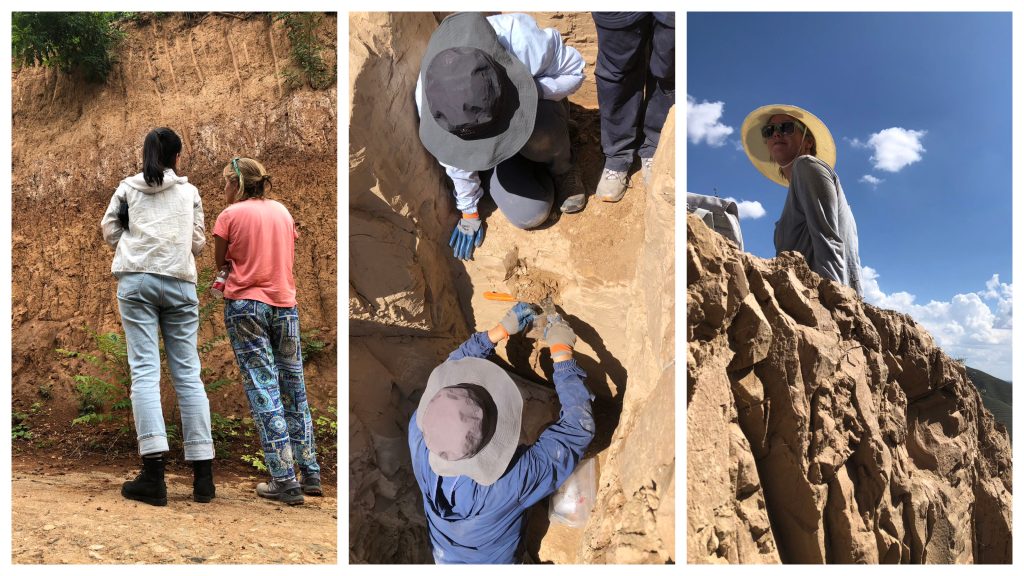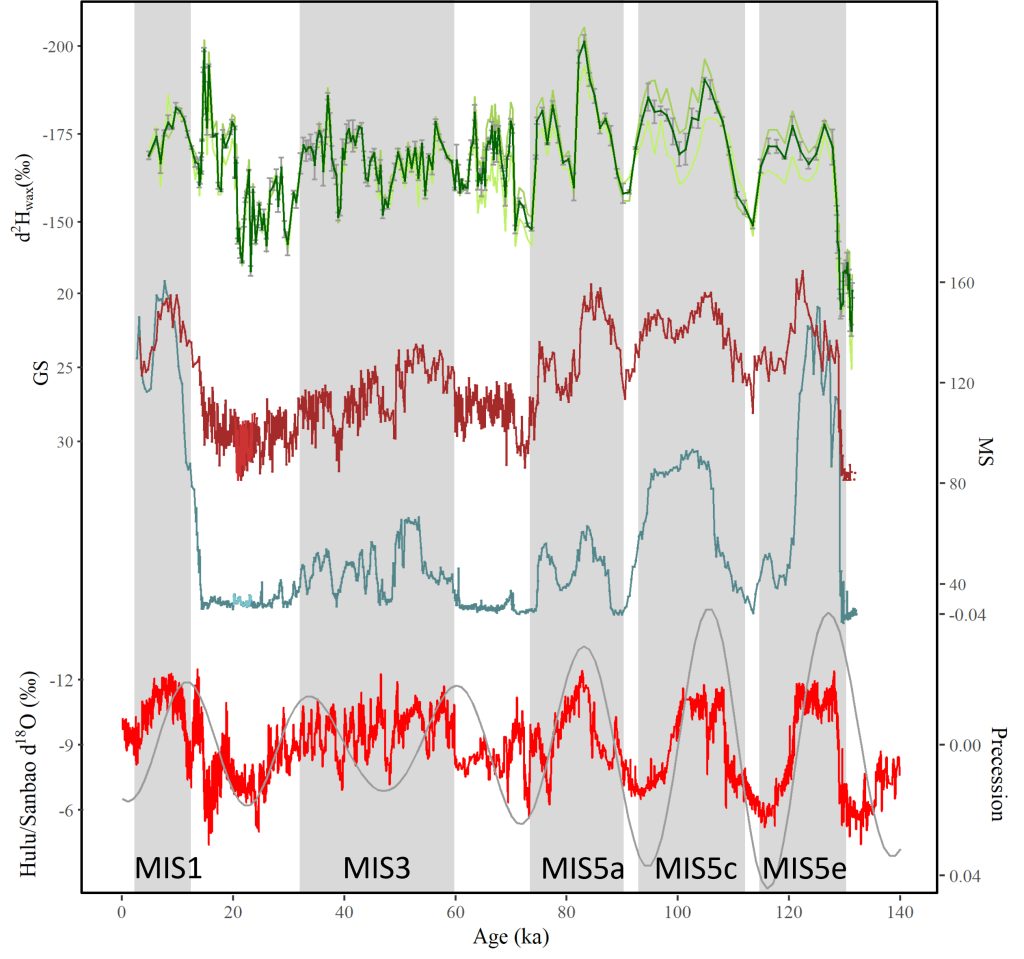NESSC study: missing link of the Asian monsoon riddle
A newly arrived NESSC article explains the variability of the East Asian monsoon records!
In the article, now published in Communications Earth & Environment, Louise Fuchs (Utrecht University) and her colleagues show how their scientific detective work can explain more about the changing climate conditions of the monsoon in East Asia. Louise writes in her own words more about her research and her finding.
Summer 2023. After three years in my PhD, I finally embark on my journey to China, with my supervisor and two colleagues from Utrecht University. Our main destination: the Chinese Loess Plateau, an over hundred meters thick pack of wind-deposited dust. Our very special study site, Yuanbao, is situated in the western Chinese Loess Plateau. But what is the reason I want to see this place, what is it that makes this site so special?
For that, we need to talk about rain, and particularly about the rains of the East Asian Summer Monsoon. This is one of the strongest monsoon systems on Earth, supplying freshwater to over a fifth of the World’s population. The East Asian Summer Monsoon is characterized by warm and wet climate conditions, and it delivers about 80 percent of the annual precipitation to Chinese Loess Plateau.

The Plateau is regarded as one of the best continental paleoclimate archives on land. Succeeding cycles of glacials and interglacials have resulted in the deposition of alternating layers of loess and paleosols. The East Asian Monsoon dominates during interglacial periods of time, whereas a winter monsoon, transporting cold, dry air from the Siberian High from the northwest toward the equator dominates during glacial periods.
Variations in strength
The above picture (Fig. 1) shows a loess-paleosol sequence from the southern part of the Chinese Loess Plateau. The darker layers represent paleosols which are deposited and formed during interglacial periods when the summer monsoon prevails. The lighter layers consist of loess. They are deposited during the cold glacial periods, when the winter monsoon is dominant. Records of past East Asian Monsoon climate have been derived from changes in sediment properties like grain size and magnetic susceptibility, which have been related to glacial-interglacial variations in the strength of the winter and summer monsoons, respectively.
There is another archive that records the East Asian monsoon climate: speleothems from caves located in southern China. The oxygen isotopic composition of the speleothem carbonate (δ18O) is related to the strength of the East Asian summer monsoon.
However, researchers have had difficulties reconciling both records. Although both loess magnetic susceptibility and speleothem δ18O supposedly reflect the same parameter (namely, the strength of the summer monsoon), the loess records are dominated by glacial-interglacial (100,000 years, i.e. 100 kyr) cycles, whereas the speleothem record contains a strong precession signal (23 kyr cycle). This mysterious paradox is known as the ‘the Chinese 100-kyr problem’. So which one of these records represents the most accurate signal and can tell us more about the climate conditions? This is what I and my colleagues set out to study.

The missing link
We wanted to study this problem using a lipid biomarker approach. Specifically, we aimed at using plant waxes. Plant waxes are very useful in paleoclimatology as they are generally well preserved in sedimentary archives plus they are resistant to degradation. Plants use soil water, ultimately derived from precipitation, to synthesize their lipids, including the plant waxes. In result, the plant waxes record the isotopic signal of monsoon precipitation, which is exactly what is also reflected by the speleothem δ18O. Hence, taking this method to the Chinese Loess Plateau would allow us to generate a record of EASM precipitation for the Chinese Loess Plateau that is directly comparable to the speleothem δ18O record, as well as to the magnetic susceptibility record from the same loess section. It can thus potentially form the missing link between the two.
The added value of our study site Yuanbao, on the western Chinese Loess Plateau, is that it lies close to the dust source of the Gobi desert and therefore has a very high sedimentation rate. This enables us to generate super high-resolution records. However, as my PhD started in January 2020, the coronavirus pandemic cancelled all our fieldwork plans for the first three years of my project, so I took on to working on material that was made available by my Chinese colleagues. Still, it wasn’t until this summer, when I got to see the Yuanbao section with my own eyes (Fig. 2), accompanied by our Chinese collaborators, that everything suddenly made sense.

So now to our results! Here are the key points of our paper:
- We try to solve the ‘Chinese 100-kyr problem’ by generating a ~130 kyr high resolution record of plant wax hydrogen isotopes (δ2Hwax) for a loess section on the western Chinese Loess Plateau that can directly be compared with records of both speleothem δ18O and with magnetic susceptibility from the same study site.
- Variations in δ2Hwax follow the precessional cycle of speleothem δ18O, which is different from the glacial-interglacial changes in magnetic susceptibility in the same loess section (Fig. 3).
- We propose that the offset is introduced by a distinct seasonality in the records. Where δ2Hwax mainly records precipitation during the plant growing season, magnetic susceptibility likely represents an annual signal, including both precipitation and temperature. The latter introduces the 100 kyr component in the record.
- Our interpretation implies that precession dominated low-latitude insolation is the main driver of East Asian summer monsoon precipitation and that glacial-interglacial climate change dominates annual average climate variability in the East Asian Monsoon
The difference in the main cyclicities between the loess proxies and the water isotopes (δ2Hwax and speleothem δ18O) thus has high potential for distinguishing the orbital and glacial imprints on East Asian Monsoon variability for further studies!
Louise Fuchs
Article
Isotopic and magnetic proxies are good indicators of millennial-scale variability of the East Asian monsoon
Louise Fuchs, Jingjing Guo, Enno Schefuß, Youbin Sun, Fei Guo, Martin Ziegler & Francien Peterse
Communications Earth & Environment, 2023
https://doi.org/10.1021/acs.est.3c04230

